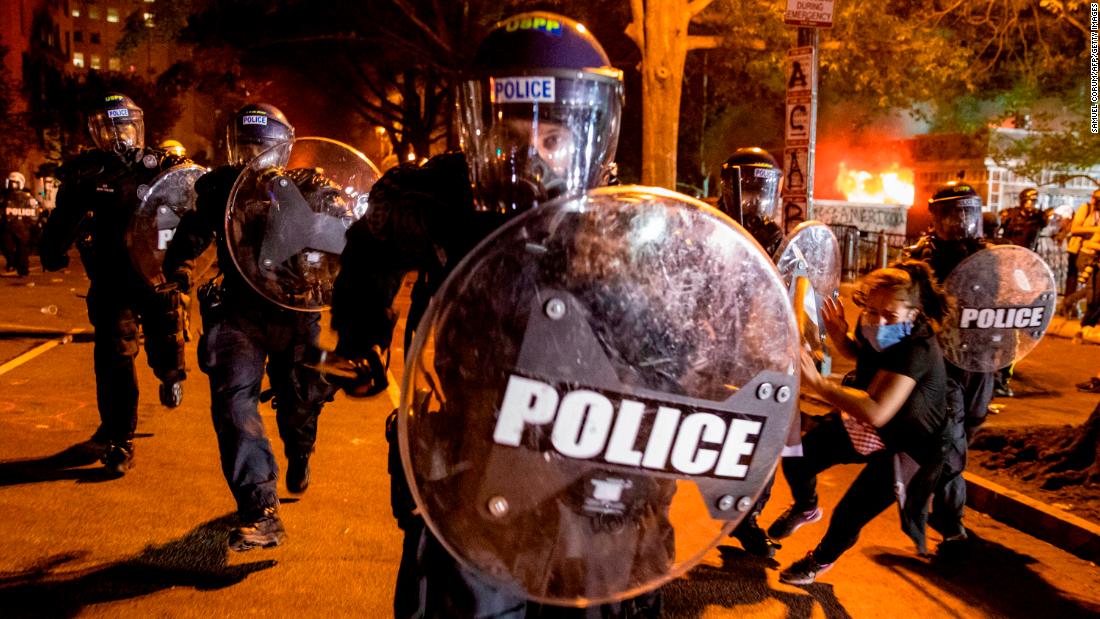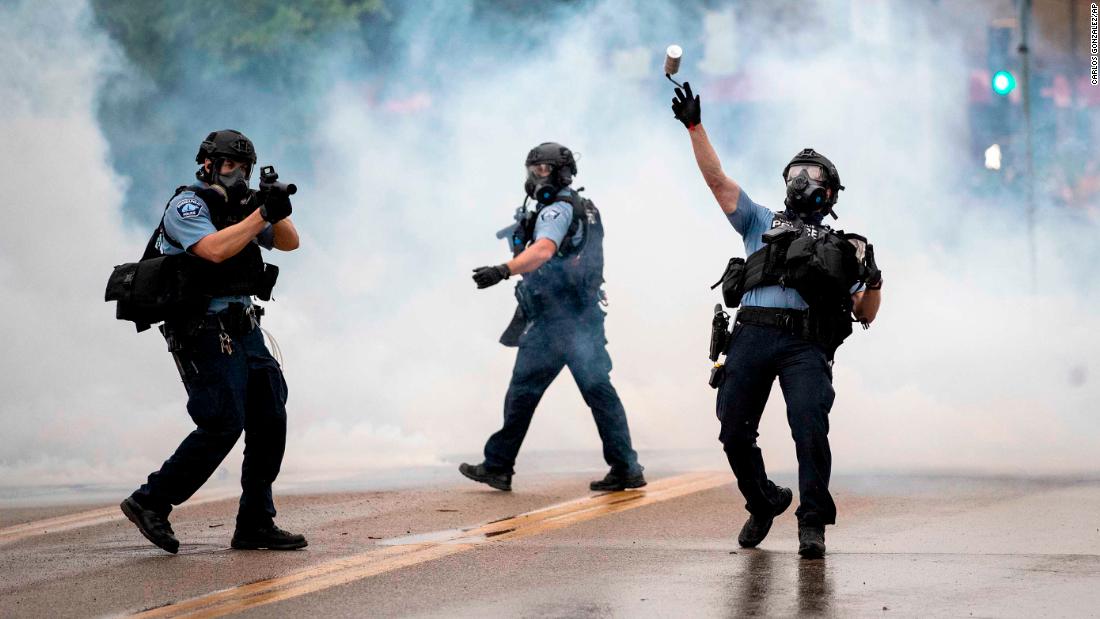
War Crimes Team Investiges Portland Police.
The Results Are Damning
Tim Dickinson / Rolling Stone
(April 18, 2023) — A British research group that typically investigates war crimes and human rights abuses has turned its spotlight on Portland law enforcement, releasing a damning report on the use of chemicals against demonstrators by the Portland Police Bureau during the 2020 George Floyd protests.
The international investigation is yet another black eye for a Portland Police Bureau that has become synonymous with brutality — in particularly against “dirty hippies” — and which has been subject to federal supervision for more than a decade.
The investigative findings released Monday by Forensic Architecture are stark:
- On the night of June 2, 2020 — infamous to locals as “Tear Gas Tuesday” — Portland Police fired nearly 150 “tear gas” munitions across a tight area of downtown.
- The CS gas deployed resulted in protesters being exposed to concentrations far higher than those deemed “immediately dangerous to life and health” by a federal agency. In some instances, that safety threshold may have been exceeded by 2,200 times.
- Clouds of chemical compounds spread half a mile, hanging in the air between downtown buildings for hours that night. With settling and runoff, more than four pounds of the caustic compounds polluted the nearby Willamette River, threatening wildlife.
Based at the University of London, Forensic Architecture is renowned for high-tech investigation techniques that combine open-source video evidence and computer modeling to reconstruct front-line horrors in places like Syria and Mariupol, Ukraine. This rare investigation of abuses in the United States builds on a previous FA investigation of tear gas deployment against protesters in Chile. (The new FA study was first reported by The Guardian.)
Chemical agents like CS or “tear” gas are banned in warfare by the Geneva Conventions. But they’re still permitted — and frequently deployed — as crowd-control agents in American policing.
Forensic Architecture trained its focus on Portland after the Oregon city gained infamy as an epicenter of police violence directed at anti-police-violence demonstrators, as well as against journalists covering those protests. Protests roiled Portland for more than 100 consecutive days in the summer of 2020, exacerbated by the Trump administration’s July incursion of irregular federal forces, itself marked by copious use of tear gas.
As detailed in the FA investigation, the Portland Police did not maintain records of “what or how many” munitions it fired that June night. To reconstruct events, FA gathered open-source intelligence, including videos posted to social media and private footage from activists and other witnesses. It then scoured the videos for distinctive visual signatures of chemical munitions known to exist in the PPB arsenal.

FA collected technical data about the quantities of chemicals in these munitions. It then created a 3D computer model of downtown Portland. After geolocating and time-synching the video footage, FA could then simulate the point-source emissions of tear gas, and how the fluid dynamics of the airflow downtown that night carried the gasses. Using this elaborate model and days of computing power, FA then measured concentrations of the caustic chemicals faced by protesters and that leached into local waterways.
The methodology is complex. But the FA visualization of its investigation, embedded below, conveys what is at heart a simple story about law-enforcement excess and the indiscriminate use of health-threatening chemical agents during a respiratory pandemic:
Robert Trafford, an assistant director of FA, emphasized to Rolling Stone that the group’s findings likely understate the risk faced by protesters. “We’re building models of reality; there are variables that can’t be captured,” he says, including munitions that were not captured on video. “We consider every input with scientific patience and care, and draw careful limits around what we don’t know,” he says, “to make sure that we are low-balling our figures [and] not falling prey to exaggeration.”
The Occupational Health and Safety Administration has found that a CS gas concentration of 2 milligrams-per-meter-cubed is “immediately dangerous to life and health.” PPB records reportedly recognize this standard.
The FA model cannot recreate exact air-quality measurements, but can reproduce the intensities of exposures protesters likely faced. In the worst “sample” studied, FA found demonstrators could have confronted CS concentrations of more than 2,000 times the OSHA limit. Even if that datapoint is discounted as an outlier, every other location sampled in FA the investigation also exceed the OSHA limit.
“This is a very painstaking and complicated way to say something that was intimately understood by everybody who was at the protest,” Trafford says. “That this was reckless and dangerous policing. This is a testament to the total bankruptcy of the use of tear gas as as a protest management tool.”
FA’s findings add to those of a federal judge. PPB’s use of tear gas inspired a federal class action lawsuit as well as changes to state law. In mid-June 2020, judge Robert Hernandez placed a temporary restraining order on PPB, citing evidence that “tear gas was used indiscriminately”; that “officers fired cannisters of tear gas at protestors without warning or provocation”; that “crowds were surrounded by tear gas without available avenues of escape”; and that “protesters were confronted with tear gas while trying to follow police orders and leave the demonstrations.”
The plaintiffs were ultimately awarded $250,000 as part of a settlement that requires PPB to strictly adhere to new state law and bureau policies on tear gas.

On the day after “Tear Gas Tuesday,” Portland Mayor Ted Wheeler, who also serves as the police commissioner, publicly praised his cops for “doing everything they can within their power to respect and protect peaceful demonstrators.”
A few days later, he directed cops to only use tear gas only when confronting a “serious and immediate threat to life safety.” Not long after getting tear gassed himself during the federal incursion into Portland, Wheeler issued a broader, September 2020 directive to police to block use of CS gas for crowd control.
Presented with the FA findings, Portland Police Bureau said in a statement: “We can’t provide comments due to pending litigation.” A spokesperson for Wheeler said, “We have not yet seen the report but look forward to reviewing it.” He highlighted the mayor’s CS directives, and added: “These unprecedented events characterize one of the most difficult chapters in our city’s history, and I believe we have taken what we learned to move Portland forward in many positive ways.”
The newly documented excesses by Portland police underscore longstanding problems across America. “U.S. policing has, time and again, demonstrated itself to be operating along militaristic lines that are unproductive any of society’s stated goals for its police forces,” Tratford says.
He also insists that the FA investigation brings into sharp relief a do-as-I-say-not-as-I-do attitude in America’s stance toward repression of protest. “This is the kind of sustained, repeated inflicting of harm on a civilian population that the U.S. federal government has castigated countries around the world for — happily and frequently,” he says.
While hopeful that FA’s model will be useful for those seeking accountability for the harms of a diffuse weapon like tear gas, Trafford is pessimistic about the prospect for a change in police practice.

“What this consistent use of tear gas demonstrated in the case of the protests in 2020 — and what we are sure it will demonstrate the next time that there is such a major uprising — is that U.S. police have very little idea how to safely and responsibly manage Amercians’ right to protest,” he says. “We’ve seen routinely that they will invest in making situations more dangerous, and more harmful, than almost any other response would have done.”
Posted in accordance with Title 17, Section 107, US Code, for noncommercial, educational purposes.